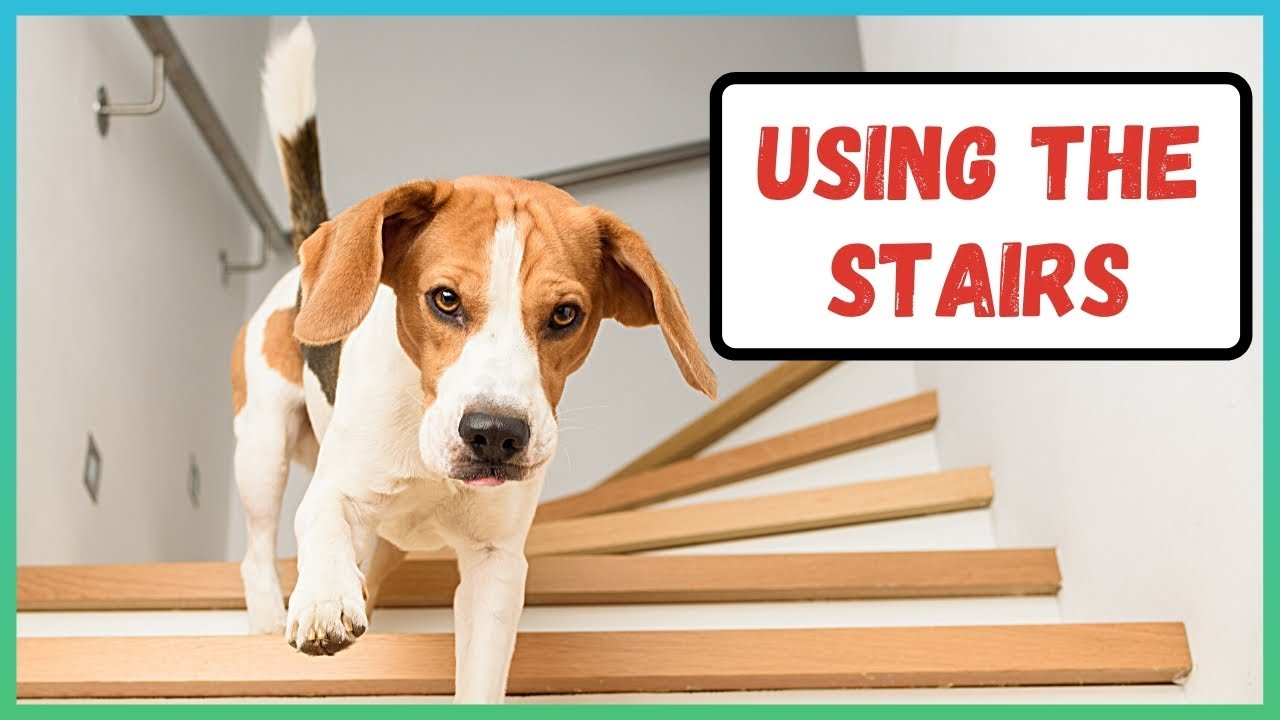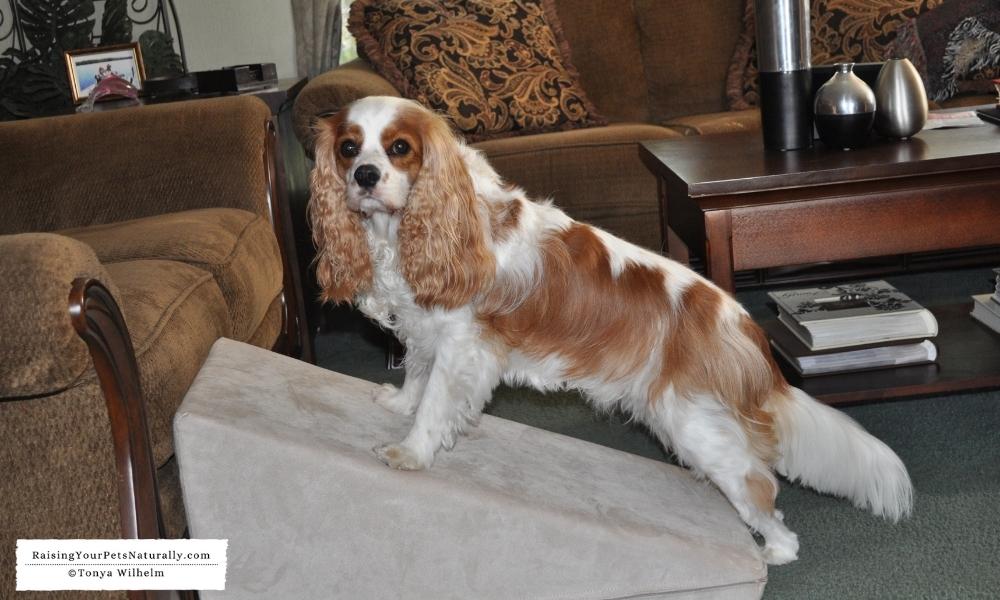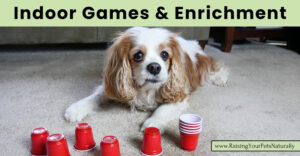Teach Your Dog How to Walk Down Steps

Is your dog or puppy afraid to go up and down the steps, or maybe he’s not too sure about his dog steps or his dog ramp? If so, I have some puppy training tips for you.
Today, I’m going to give you a few tips on how to teach your dog or puppy to use their dog ramp or to go up and down your household steps. I will demonstrate first with Dexter with his dog steps and his ramp, then I’ll flashback to little puppy Haru going down his basement steps. So, you’ll get to see a new puppy in action.
You can view it all in this video below. Don’t forget to subscribe to my channel for more free content.
First thing first. As you may already know, jumping down from objects such as a sofa or a bed is really hard on your dog’s body. This jumping action can actually cause injury to their shoulders, spine, and neck. So, it’s a no-no in our house. You can read more about that in this blog.
I have dog steps that go up to Dexter’s sofa. Yes, it is Dexter’s sofa. 

If your dog used to go up and down steps and now all of a sudden is having issues, please speak to your dog’s veterinarian, as there may be an underlying medical condition or issue that needs to be addressed first. If your dog’s vet gives you the green light, then it might be a behavioral issue, and then we’ll address that right here in today’s dog blog.
Evaluating the Steps or Ramp
Think about the steps you are wanting your dog to use. Some steps are actually slick, and they are not carpeted. This can be really challenging for a dog. If at all possible, please consider adding a secure runner to your steps. This will make them much safer and more enjoyable for your dog. Also, if you have indoor steps, I would highly recommend a baby gate so your dog doesn’t do a tumble down the steps and hurt himself. Dogs falling down steps is actually more common than you might think.
You can watch as I demonstrate with Dexter how to use the steps.
It’s always easier on the dog if you place him on the second-to-the-bottom step instead of the top step. Going down two steps is less daunting and scary.
With the treats in your hand, place them by your dog’s nose and lure his head down the first step. Only focus on one step at a time. Yes, and treat for any movement, even if it’s just his head dropping down. If he places a paw or two, tell him how smart he is while providing him a few treats from your hand.
This could take some encouragement and some time. Don’t feel like you need to master all the steps at once. Slow and steady is also safer vs. rushing down.
You can also work from the bottom steps and work your way up. With the treats in your hand, lure your dog’s head up the step and, once again, reward for any attempt. This stage might actually take some time. It might be more than one session. Reward any little bit your dog gives you. Even one step down or a little look, all that’s fantastic. “What a good boy you are!”
Tips
You can also use your body as a buffer to help your dog feel comfortable with the steps. Instead of putting their paws on the step to go up or down, they can put their paws on you. You can slowly transition your puppy from your body to the steps.
Watch this clip as I use my legs as a buffer for Haru.
Dog Steps vs. Dog Ramps
Now, some dogs find ramps much easier to navigate, because they don’t have that step height. If you do choose steps, you need to find a set that has the right height for your dog. If you have a little tiny dog and the steps are too high, it would be like trying to climb Mount Everest. Pay attention to that height for your dog and the stability. If it’s too wobbly, that might really scare them.
And don’t forget the surface of the steps. If the stops are slick, they may not want to step up. A texture that is easy to navigate and has a nice grip is ideal. The width is also key. A narrow width and wide gait just don’t mix. The wider usually the better. The shallower the step, usually the better too. Ramps tend to be a little easier for some dogs because there is no real step up involved.
You always want to pay close attention to your dog and their behavior to make sure they’re not falling off places. Especially with some silly dogs or blind dogs, you’re going to want to make sure that your steps or your ramp have a rail so they don’t tumble off.
You can do a little treat trail on one step. Then lure your dog with the treat a bit farther up the step or ramp. Give your dog the treat and a “good job.” You can also reverse the process for going down the steps. Go slow, so your dog doesn’t just jump off. You want him to move down the steps slowly and safely.
Going down can be really scary, especially on a set of stairs in the house because they tend to have many steps. As your dog or puppy looks down, it can be daunting. I like to actually pick up the dog and place him on the lower steps, say step 2, facing down. Then I can do the training from there and build up a dog’s confidence. Work two steps up and then two steps down, two steps up, two steps down, three steps up, three steps down because then it won’t be so scary.
Basement steps can be a challenge for some dogs if the basement steps are dark or it’s a bit scary down there. Hey, I don’t always want to go down to the basement either. LOL
Take a good look at the steps and environment from your dog’s point of view. Does it look steep? Is it dark? Am I leaning over the edge? Do I have secure footing?
Hopefully, this post and video provided you with a few tips to help your dog or puppy use the stairs. If so, consider subscribing to my YouTube channel and newsletter for more free content.
Some final thoughts are, that you want to remember to be consistent and patient, especially if your dog’s been consistently pottying on potty pads for many years. Again, reacting like us seeing a toilet. That change is going to take time. Don’t get frustrated. Don’t get harsh. Don’t yell at your dog because that stress and anxiety will make things worse.
Your questions or comments are welcome below.
Are you looking for even more ways to stay up to date with Raising Your Pets Naturally? Sign up for the newsletter for more tips and promotions. Don’t forget to be social and Like, Follow and Subscribe. Comments below are always welcome.
Facebook Twitter Pinterest Instagram YouTube

Proactive Puppy Care |

If you found my blog helpful, please consider a small contribution. Dexter and I thank you! |
Google Adsense—>



